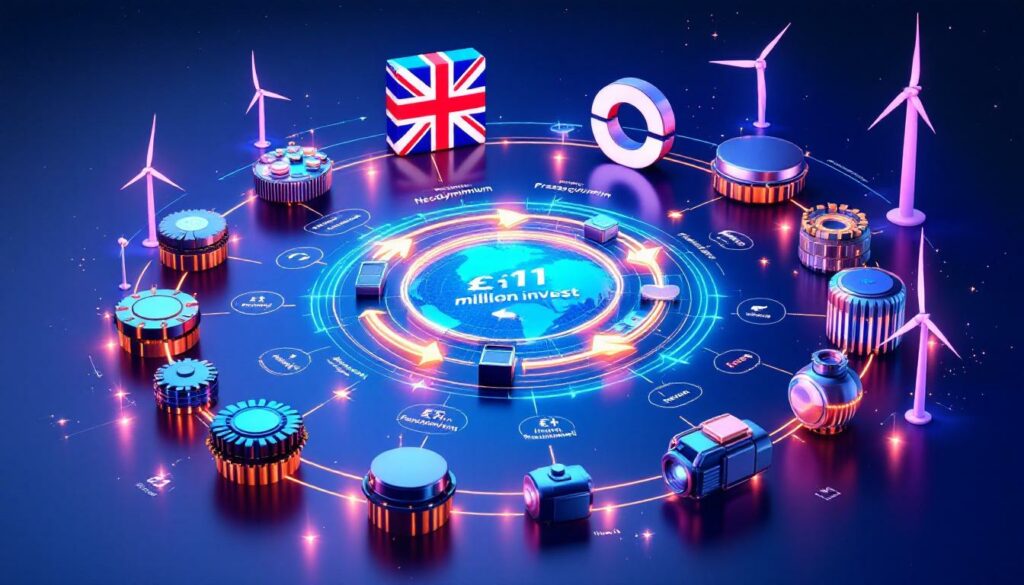How Is the UK Government Supporting Rare Earth Supply Chains?
The United Kingdom has made a landmark investment to secure its position in the global rare earth elements (REE) supply chain. A substantial £11 million (A$22.6 million) funding package has been directed to Ionic Technologies' innovative "CirculaREEconomy" initiative, representing a strategic commitment to reducing foreign dependency on these critical materials.
This investment aims to establish a sustainable and sovereign rare earth permanent magnet (REPM) supply chain within the UK borders, with particular focus on supporting the rapidly expanding electric vehicle sector. The funding comes through the UK Government's DRIVE35 program, a broader £2.5 billion initiative focused on accelerating the transition to net-zero transportation.
"IonicRE is delighted to receive this hugely welcome and additional support from the APC as we build a sovereign and sustainable UK-based rare earth permanent magnet supply chain," noted Tim Harrison, managing director of Ionic Rare Earths.
Brett Lynch, executive chairman of Ionic Rare Earths, further emphasized: "This is a significant demonstration of the UK government's support for the development of a sovereign, secure and sustainable rare earth supply chain."
What Are Rare Earth Elements and Why Do They Matter?
Critical Components for Modern Technology
Rare earth elements comprise 17 metallic elements on the periodic table that have become indispensable in modern manufacturing. Despite their name suggesting scarcity, most REEs are relatively abundant in Earth's crust but rarely found in concentrations that make extraction economically viable.
These elements are essential for manufacturing high-performance magnets used in electric motors, wind turbines, and various defense applications. Their unique magnetic, luminescent, and electrochemical properties make them irreplaceable in many high-tech applications, particularly those requiring strong, lightweight magnets.
Strategic Importance in the EV Revolution
Permanent magnets containing neodymium, praseodymium, dysprosium, and other rare earths are crucial components in the permanent magnet synchronous motors (PMSMs) that power most electric vehicles. These magnets deliver superior performance, efficiency, and power density compared to alternatives.
A typical electric vehicle contains approximately 1-2 kg of rare earth elements, with the majority concentrated in the motor magnets. As global EV production accelerates—with projections suggesting 145 million EVs on roads by 2030—securing stable access to these critical minerals energy transition has become a strategic priority for automotive manufacturing nations.
Current Supply Chain Vulnerabilities
China currently dominates global rare earth processing and magnet manufacturing, controlling approximately 85% of the global market. This concentration creates significant supply chain vulnerabilities for Western nations, especially after China's recent export restrictions on critical rare earth materials.
"With the export of REPMs from China effectively turned off in April, the customer base has felt first-hand the risk of complete dependence on a monopolistic supply chain," noted Tim Harrison.
This monopolistic control has prompted countries like the UK to develop alternative supply chains, with recycling and circular economy approaches gaining traction as sustainable solutions that reduce dependency on primary mining operations concentrated in geopolitically sensitive regions. The ongoing US-China trade strategies have further complicated the global rare earth market.
What Is the CirculaREEconomy Initiative?
A Collaborative Approach to Sustainable Rare Earth Supply
The CirculaREEconomy project represents a pioneering approach to establishing a circular rare earth supply chain within the UK. Led by Ionic Technologies, a wholly owned subsidiary of Ionic Rare Earths Ltd, the initiative brings together a consortium of industry leaders to create a complete ecosystem for rare earth processing and magnet manufacturing.
This three-year project takes a holistic view of the rare earth value chain, addressing everything from recycling end-of-life magnets to manufacturing new high-performance components for electric vehicles. By adopting circular economy principles, the initiative aims to reduce waste, lower environmental impact, and maximize the value of rare earth materials already in circulation.
The project demonstrates a shift in thinking about critical minerals—moving from a linear "extract-use-dispose" model to a circular approach where materials are kept in productive use for longer periods, reducing reliance on volatile international supply chains.
Key Project Partners and Their Roles
Automotive Industry Leaders
The consortium includes major automotive manufacturers who will provide crucial end-user input:
- Ford Technologies – Contributing specifications and testing capabilities for EV drivetrains
- Bentley Motors – Bringing expertise in luxury vehicle propulsion systems
- Wrightbus – Adding perspective from commercial and public transport applications
These companies will ensure that the magnets produced through the initiative meet the demanding requirements of electric vehicle applications, from performance characteristics to durability standards.
Materials and Recycling Specialists
Technical partners in the supply chain include specialized organizations at each stage of the process:
- Less Common Metals – Leading rare earth alloy producer providing metallurgical expertise
- European Metals Recycling – Contributing advanced materials recovery techniques
- British Geological Survey – Offering scientific and technical expertise in mineral processing
- Vacuumschmelze and GKN Powder Metallurgy – Bringing magnet manufacturing capabilities
This diverse consortium ensures coverage of the entire value chain, from raw material recovery to finished magnet production, with each partner contributing specialized knowledge and capabilities.
Innovative Technology and Processes
Proprietary Recycling Methods
Ionic Technologies will utilize its proprietary long-loop hydrometallurgical recycling technology to process rare earth materials, including those recovered from end-of-life magnets. This advanced chemical processing approach enables the selective separation and purification of individual rare earth elements from complex waste streams.
The technology produces high-purity, separated rare earth oxides (REOs) that meet the stringent specifications required for manufacturing new magnets. This capability represents a significant advance in rare earth recycling, as it maintains the quality and performance characteristics of virgin materials while reducing environmental impact.
Unlike some alternative approaches that downcycle rare earth materials into lower-value applications, this technology maintains the full functional value of the materials, enabling true circular use in high-performance applications.
Belfast Demonstration Plant
The company's demonstration facility in Belfast serves as the hub for processing activities, showcasing the technical feasibility of creating a closed-loop rare earth supply chain within the UK. This facility has already produced initial batches of rare earth oxides, validating the technology at scale.
The Belfast plant functions as both a commercial demonstration facility and a development center, allowing for continuous process optimization and technology refinement throughout the project duration. Its central role in the CirculaREEconomy initiative highlights the importance of having physical infrastructure in place to anchor theoretical supply chain models.
How Does This Initiative Align With UK Government Priorities?
DRIVE35 Program and Net-Zero Transition
The £11 million funding comes through the UK Government's DRIVE35 program, a £2.5 billion initiative aimed at supporting the transition to a net-zero automotive sector. The Advanced Propulsion Centre UK (APC) is facilitating this program, which focuses on developing electric drivetrain technologies and reducing the UK's carbon footprint.
DRIVE35 specifically targets technologies that will help the UK automotive industry reach net-zero carbon emissions while maintaining competitive advantage in the global market. By supporting rare earth magnet production, the program addresses a critical component of electric vehicle manufacturing—one that might otherwise constrain domestic production capabilities.
The initiative aligns perfectly with the UK's legally binding target to achieve net-zero carbon emissions by 2050, recognizing that transportation electrification is a central pillar of this strategy, requiring secure supply chains for critical components.
Strategic Independence and Supply Chain Security
Reducing Dependence on Foreign Imports
The CirculaREEconomy initiative directly addresses the UK's strategic goal of reducing dependence on imported rare earth materials, particularly from China. By establishing domestic capabilities for processing and recycling rare earths, the UK aims to secure its supply chain for critical components in the growing electric vehicle and renewable energy sectors.
This approach reflects a broader trend among Western nations to "onshore" critical supply chains following disruptions experienced during recent global events. For the UK, which aims to phase out new petrol and diesel vehicles by 2030, securing the components needed for electric alternatives represents a strategic imperative.
Similar efforts are underway across Europe, with the European CRM facility representing another approach to securing critical raw materials supply chains. In the United States, a critical minerals order has similarly aimed to reduce foreign dependency.
Response to Recent Export Restrictions
As Tim Harrison noted: "With the export of REPMs from China effectively turned off in April, the customer base has felt first-hand the risk of complete dependence on a monopolistic supply chain." This initiative represents a concrete step toward mitigating those risks.
China's recent policy shifts regarding rare earth exports have served as a wake-up call for many nations, accelerating efforts to develop alternative supply chains. The UK's investment in the CirculaREEconomy project demonstrates a proactive approach to addressing this vulnerability before it significantly impacts the nation's industrial strategy.
What Environmental Benefits Will the Project Deliver?
Sustainability Advantages of Circular Supply Chains
Carbon Footprint Reduction
The three-year project will investigate and document the environmental benefits of circular rare earth supply chains, including potential reductions in carbon emissions compared to traditional primary mining-based supply chains.
Preliminary research suggests that recycling rare earth elements can reduce energy consumption by 60-70% compared to primary extraction, with corresponding reductions in greenhouse gas emissions. By utilizing existing materials rather than extracting new ones, the initiative could significantly reduce the carbon footprint of rare earth magnets used in UK manufacturing.
The project will establish baseline carbon metrics for recycled versus virgin materials, providing valuable data to support broader adoption of circular approaches across the rare earth industry.
Resource Conservation
By recovering and recycling rare earth elements from end-of-life magnets and other sources, the initiative helps conserve natural resources and reduces the need for environmentally intensive mining operations.
Traditional rare earth mining and processing can generate significant quantities of radioactive waste and toxic byproducts. In contrast, recycling existing materials avoids these environmental impacts while reducing pressure on limited natural resources.
This approach is particularly valuable for dysprosium and other heavy rare earth elements, which are more scarce and typically extracted through more environmentally damaging processes than their light rare earth counterparts.
Waste Reduction
The circular approach minimizes waste by keeping valuable materials in use for longer periods, addressing a key environmental challenge associated with electronic waste disposal.
Currently, less than 1% of rare earth elements are recycled globally, representing a significant lost resource. The CirculaREEconomy initiative aims to demonstrate commercially viable approaches to capturing this value, establishing processes that can be scaled and replicated to address the growing volume of end-of-life electronic products containing rare earth magnets.
What Are the Economic Implications for the UK?
Building Domestic Manufacturing Capabilities
Job Creation and Skills Development
The establishment of a domestic rare earth processing and magnet manufacturing industry is expected to create high-skilled jobs and foster technical expertise within the UK. These positions will span the value chain, from recycling operations to advanced materials processing and manufacturing.
Beyond direct employment, the initiative will contribute to developing a skilled workforce with expertise in critical minerals and advanced manufacturing—capabilities that have strategic value across multiple sectors of the economy.
The project also includes knowledge transfer components that will help build UK technical capacity in rare earth processing, an area where expertise has historically been concentrated in China and a few other countries.
Supporting the EV Manufacturing Ecosystem
By securing access to critical components, the initiative helps position the UK as a competitive location for electric vehicle manufacturing, potentially attracting additional investment in the automotive sector.
Access to locally produced rare earth magnets removes a potential supply chain bottleneck for UK-based EV manufacturers, improving their resilience against international market disruptions and potentially reducing costs through shorter supply chains and reduced logistics.
This capability becomes increasingly important as mining industry evolution continues to reshape global supply chains for critical minerals. As automotive production transitions from internal combustion engines to electric drivetrains, these capabilities will have significant implications for the UK's manufacturing base and export potential.
Technology Leadership
The development of innovative recycling and processing technologies could establish the UK as a leader in sustainable rare earth supply chains, creating opportunities for technology export and international collaboration.
As other nations seek to reduce their dependence on Chinese rare earth supplies, proven technologies for recycling and processing these materials will have significant market potential. The UK's early investment positions it to capture value from this growing global demand for alternative supply chain solutions.
The knowledge and intellectual property generated through the CirculaREEconomy project could become valuable exports in their own right, complementing the physical materials and components produced through the initiative.
How Will Ionic Technologies Benefit?
Financial and Strategic Advantages
Direct Funding Support
Of the £11 million total funding, Ionic Technologies is set to receive approximately £3.1 million (A$6.4 million) over the course of the project, supporting its continued development and commercialization efforts.
This substantial financial contribution reduces the company's development risk and accelerates its technology commercialization timeline. The funding structure also provides validation of the company's approach, potentially making it easier to secure additional investment for future expansion.
The government backing provides a stable financial foundation for the three-year project period, allowing the company to focus on technical execution rather than short-term funding concerns.
Market Positioning
The initiative strengthens Ionic Technologies' position as a key player in the global rare earth recycling and processing sector, potentially opening doors to additional partnerships and business opportunities.
As Mining.com reports, Ionic Technologies is becoming one of the few Western companies with demonstrated rare earth processing capabilities and stands to benefit from growing demand for alternative supply chains. The CirculaREEconomy project provides a high-profile platform to showcase these capabilities to potential customers and partners.
The consortium structure also connects the company directly with major end-users in the automotive sector, creating valuable commercial relationships that could extend beyond the initial project scope.
Technology Validation
Working with major automotive manufacturers provides valuable validation of Ionic Technologies' processes and products, demonstrating their commercial viability and performance in demanding applications.
This real-world validation is particularly important in the rare earth sector, where material specifications and performance requirements are extremely stringent. Successfully meeting the needs of companies like Ford and Bentley will significantly strengthen Ionic Technologies' market credibility.
The project's documentation of environmental benefits also supports the company's value proposition around sustainable processing, potentially opening access to ESG-focused investment and customers with strong sustainability commitments.
What Challenges Remain for Rare Earth Supply Chain Development?
Technical and Commercial Hurdles
Scaling Production Capacity
Moving from demonstration-scale to commercial-scale operations represents a significant challenge, requiring substantial investment and technical optimization. The current Belfast facility has proven the technology works, but achieving economic production volumes will require further scaling.
Technical issues that may be manageable at demonstration scale can become significant hurdles at commercial scale, particularly around process consistency, quality control, and throughput rates. The consortium will need to address these challenges to achieve commercial viability.
Additionally, securing sufficient feedstock (end-of-life magnets and other rare earth-containing materials) to support commercial-scale operations remains a logistical challenge that will require development of effective collection and pre-processing systems.
Cost Competitiveness
Achieving cost parity with Chinese-produced rare earth materials and magnets remains a challenge, particularly given China's scale advantages and lower environmental compliance costs.
Chinese producers benefit from decades of government investment, established infrastructure, and economies of scale that new entrants like Ionic Technologies must overcome. While security of supply and environmental benefits provide some market advantage, price competitiveness remains important for widespread adoption.
The consortium will need to continuously improve process efficiency and reduce costs throughout the project to establish a commercially sustainable operation that can compete in global markets without permanent subsidies.
Supply Chain Integration
Establishing a fully integrated supply chain requires coordinated development across multiple industries and companies, with potential bottlenecks at various stages.
Each step in the rare earth value chain—from collection and dismantling of end-of-life products to separation, alloying, and magnet manufacturing—requires specialized expertise and equipment. Ensuring these capabilities develop in parallel and at compatible scales presents a significant coordination challenge.
The consortium approach of the CirculaREEconomy initiative helps address this challenge by bringing together partners from across the value chain, but successful integration will require ongoing collaboration and alignment of commercial interests.
Policy and Market Considerations
Long-Term Government Support
Sustaining government support beyond initial funding will be crucial for the long-term viability of domestic rare earth supply chains.
While the current £11 million investment is significant, establishing a competitive rare earth industry may require sustained policy support through mechanisms like tax incentives, research funding, or preferential procurement policies. The experience of other countries suggests that building complete rare earth supply chains requires consistent government commitment over many years.
The project's success may depend on how effectively it demonstrates both technical feasibility and strategic value, making the case for continued support beyond the initial three-year timeline.
Market Development
Creating stable demand for domestically produced rare earth materials and magnets requires policy frameworks that incentivize local sourcing and recognize the strategic value of supply chain security.
Even with technical success, the consortium must develop commercial models that convince customers to choose potentially higher-cost domestic sources over established international suppliers. This may require creative approaches to risk-sharing, long-term contracting, or value attribution for supply chain resilience and environmental benefits.
Government procurement policies could play an important role in creating initial market demand, particularly in defense applications where supply chain security carries particular strategic importance.
Want to Gain Early Access to the Next Mineral Discovery?
Discover why ASX mineral announcements can lead to significant investment returns by exploring Discovery Alert's dedicated discoveries page, where our proprietary Discovery IQ model transforms complex mineral data into actionable, real-time alerts for investors seeking a market-leading advantage: https://discoveryalert.com.au/discoveries/




